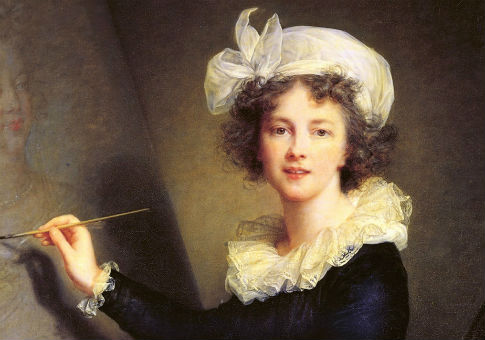Portraitists of "society" figures tend to attract business by flattering their subjects’ appearances in the final product. A few artists gain enough prominence that to be painted (or later, photographed) by them—by a Sargent, an Avedon, a Liebovitz—becomes a kind of flattery in itself, illustrating the subject’s importance, their membership in the elite.
Élisabeth Louise Vigée Le Brun, the favored portraitist of Marie Antoinette, achieved this level of fame at a remarkably young age. After a youth with its share of hardship—the death of a beloved father, himself a modestly successful portraitist, when she was 12; the acquisition of a hated stepfather who wore her father’s clothes and took her earnings; the acquisition of a husband, not hated, but who also liberally helped himself to her money—Le Brun was commissioned to paint her first portrait of the queen at the age of 23. Her Majesty’s mother, the Empress of Austria, having last seen her daughter as a child, wanted a likeness of her as an adult in full court dress.
Le Brun’s painting (on display in the fine new exhibition devoted to her career at the Metropolitan Museum of Art) was not a complete technical success. But Marie Antoinette apparently did not care about some mildly askew proportions in the architectural scenery, or the somewhat cartoonish play of the light over her panniered skirt. The queen, who was Le Brun’s exact age, had been despairing of the quality of portraitists available to her, and Le Brun’s success in depicting her face pleased her, as it did the Empress, who felt the painting captured her daughter’s bearing.

There followed a decade of professional flourishing. Le Brun’s already prodigious technical abilities improved with age, and her talent was much assisted by a pleasing manner and the fact that she was unmistakably beautiful. French painting in the final years of Louis XVI was moving in a neoclassical direction, but there was something warm and un-embarrassedly feminine to Le Brun’s work that attracted criticism at the time—and has since. In a delightfully spirited defense of Le Brun included in this exhibition’s catalogue, Joseph Baillo draws our attention to the fact that his subject was a named target of Simone de Beauvoir, who felt the artist belonged to a class of narcissists who put their feminine identity before their work: "Mme Vigée-Lebrun never wearied of putting her smiling maternity on her canvases…"
That’s a fair assessment of a narrow fact, even if it is somewhat hateful as a point of critique. "Smiling maternity"—Le Brun’s own, or that of her clients—was a frequent element to her work. Her prerevolutionary portraits, charged, in retrospect, with a certain amount of dramatic irony, depict an elite enjoying themselves at the very center of an absolutist state, not to mention a wholly unbalanced distribution of wealth. And yet her subjects appear far from grand. The women are portrayed as fashionable, light, rather sweet things: the women are mothers or comely daughters, and the men, in Le Brun’s hands, are mostly just handsome. There is no sense of divine empowerment to this elite—not even to the queen, who consented at one point to be depicted by Le Brun in a loose, fashionable chemise (a scandal ensued) and who, two years before the Revolution, sat for a grand state portrait intended to soften her image and emphasize her own smiling maternity.
If anything is clear from these early portraits, it’s that this lot had no idea what was coming. Le Brun herself was quicker than most, and fled with her daughter (but not her husband) on the 5th of October 1789, the same day that the King and Marie Antoinette were brought forcibly from Versailles to Paris. Le Brun was 34 years old, quite famous, still beautiful, at the very height of her powers—and effectively penniless. She would not return home until she was 46, having spent the intervening years grinding out a prodigious amount of likenesses for the quality (including French royalists-in-exile) in Rome, Vienna, St. Petersburg, and elsewhere.

She often met with both critical and commercial success while abroad—a high point came early, when she was invited to contribute a self-portrait to the Uffizi. But she also attracted criticism. Some said her success at commanding apparently astronomical prices was achieved less through artistic merit and more through her connections and beguiling manner. There were also personal struggles: In Russia, her now teenaged daughter Julie, a delight to Le Brun throughout her exile (and a subject for several portraits included in the Met’s exhibition) took a fancy to an unimpressive young man and insisted on marrying him. Julie stayed in the east as Le Brun continued to move, eventually returning to France in 1802. In her memoirs, Le Brun blamed this catastrophe on her daughter having been allowed to read novels.
Those memoirs were one of the products of Le Brun’s long dénouement. She died at 87, decades after retiring from painting, having enjoyed a reputation as a fascinating hostess during the Bourbon Restoration, an aging ornament of the old regime, and something of a legend. Of post-revolutionary France, Alexis de Tocqueville observed that much less had changed as ultimately had remained the same, "much as some rivers after going underground re-emerge at another point in new surroundings."
Le Brun never completely regained her status in the Parisian art world, however. Toward the end of her life, explaining her refusal to read Victor Hugo, she told a friend, "I am not of this century." The mothers and daughters and handsome fathers of this new society were not those of Le Brun’s brilliant youth, when she spent the happiest years of her life depicting the final days of a ruling elite.
